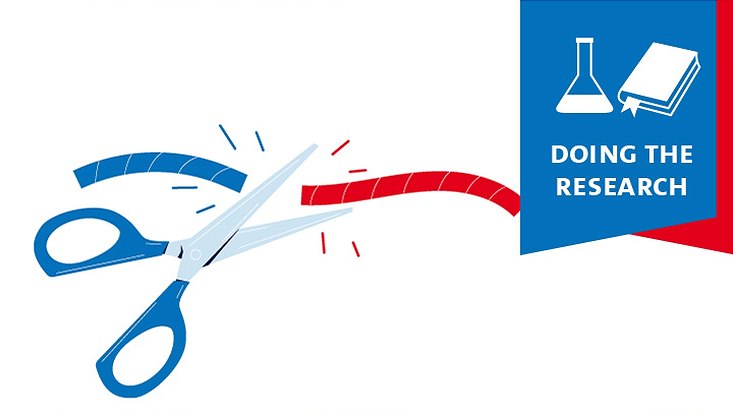Subconscious processes and the role that character playsHow to Change Unhealthy Habits in the Long Term?Doing the Research series
23 May 2024, by Anna Priebe

Photo: Universität Hamburg / Vogiatzis
Why is it easier for some people than for others to be more physically active or quit smoking? And how can health programs take these generally subconscious differences into account? Prof. Dr. Mirko Wegner, professor of health sciences at the Faculty of Psychology and Human Movement Science, is taking a closer look at this.
Your research focuses on differences in self-control. What can students expect?
We always need self-control when we don’t find things or situations very easy to handle. For example, it’s not easy for a lot of people to study in a concentrated, structured way for a test. Self-control describes inner strategies for dealing with challenges, for example, putting the cell phone aside so you can learn without disruption. These processes are also crucial if we want to change our behavior in the long term and are thus the focus of our work.
Especially the differences that arise in regard to people’s motives, for example a need for intimacy or a desire to achieve something. What does this mean exactly?
What we find easy or hard, what feels okay for us, and how we perceive a situation strongly depends on our personality and the so-called motives that also influence these. We distinguish, for example, between the achievement, the power, and the intimacy motive.
For people with a power motive, it is important and fulfilling to have an impact on other people and influence them. These people feel comfortable in leadership positions. Musicians could also have a power motive when it comes to moving an audience with their songs.
People with an achievement motive, on the other hand, are ambitious and always want to improve themselves and be successful. Deciding to study for a test may be easier for them because it satisfies their major motive. They can adapt better to the situation than, for example, someone with a strong motive for intimacy.
You focus is the intimacy motive, right?
Exactly. For this personality type, social connection is important, meaning creating and nurturing good contact to other people, a lot of social interactions, and relationships. Someone with this motive has difficulty choosing to learn for a test over meeting with their friends.
The core of the intimacy motive is less about a measurable goal than the other motives are. It’s much more about processes: people with a high intimacy motive experience joy when they are surrounded by people they really like. That is also what interests us.
These interactions do not necessarily have to have a purpose or goal. Someone with a marked intimacy motive would not, for example, think about asking a friend to come jogging to motivate themselves. The would be seen as instrumentalizing the relationship.
So getting people with an intimacy motive to change their behavior works differently than it does with people with other motives?
Yes. We presume that the motives above automatically lead to very different types of self-control. People with strong intimacy motives do not, for example, ask themselves: how can I attain this goal? They are interested in whether they currently feel good in their environment. And in stressful situations, they are very good at recognizing their own interests and needs and addressing these. They also share more with other people when they are in a stressful situation. Understanding these preferences and processes can help us to address these people better, especially when it comes to promoting health.
Does everyone have only one motive?
No. You can have the 3 motives described independently of one another and in different degrees. It’s possible that someone has only one strong motive or 2 or 3 equally strong motives at the same time. We know that motives emerge in early childhood and remain highly stable over a lifetime.
We know that motives remain highly stable over a lifetime.
How do you research these kinds of subconscious processes?
For self-control, we can use questionnaires where participants get a description of a challenge and a possible reaction—and then use a scale to evaluate to what extent the behavior described fits them. There are also experimental approaches, however, to study self-control.
To measure motives, we take a classic approach using images. You show the subjects pictures of people. The subjects are not given any context and have to answer questions about the picture in writing: What are the people pictured doing, how did the situation arise, what are the people’s goals, and what is the relationship between the people pictured?
So it is the subjects’ personal interpretation, in which they draw on their own experiences with social situations. We analyze the answers, for example, using automated coding procedures. That means that there are certain formulations and terms that indicate one or the other motive. The evaluation involves the use of AI methods.
And then you consolidate the results of both tests?
Yes. For example, we recently analyzed data from a large study with over 5,000 test subjects in which the motive values and variable measurements of self-control abilities were available. Using this dataset, we could show that the there are systematically proven differences between people with a strong intimacy motive and people with a strong power or achievement motive.
In another study, we also took a closer look at a group of test subjects with very strong intimacy motivation and extricated motive-specific self-control processes from the picture descriptions. When the test subjects describe and explain a picture showing a conflict situation, for example, and how they think the situation will develop, it is especially valuable because it provides insight into the expression of their own self-control processes not influenced by leading questions. In this case, we talk about a non-predetermined or non-respondent reaction. On the basis of this research, we have further developed standardized questionnaires on self-control and, for example, also incorporated social situations into the questions. In this way, we want to better depict what people with intimacy motives do to regulate themselves.
What are further possibilities for applying your work?
From our research projects, we know that the intimacy motive in and of itself can promote health. People with this motive, for example, have greater cardiovascular health and stronger immune systems than people with a power motive. At the same time, people with intimacy motives often work in social professions, for example, nursing care. Here, there is a high risk of stress and shift-work is often detrimental to health.
The classic intervention options in these areas have been very goal- and self-centered to date. We would like to use our research for new approaches to successful prevention measures. For example, it can be helpful to provide greater context and to not focus singularly on the goal, but also on the process on the path to the goal. This could mean, among other things, that we especially highlight social interactions at work for people with strong intimacy motives and that health behavior changes would be a by-product.
This is also the social implication of our research. We live in a performance-oriented society in which success at school, in your job, and in life are highly valued. But what about people who have a strong intimacy motive and for whom these things, and focusing on goals, are not at all important? We would like to provide them access to society, for example, with the right form of classroom instruction.
The project
Prof. Dr. Mirko Wegner has been doing research at Universität Hamburg since 2022. Together with his team, including postdoctoral researcher Dr. Ariane Marion-Jetten and doctoral researcher Ludwig Piesch, he does research on motive-specific self-control processes. They cooperate with, among others, Prof. Dr. Nicola Baumann from the University of Trier. The current preliminary studies are being conducted with the aim of submitting a grant proposal to the German Research Foundation. The project was funded through the Ideas and Venture Fund at Universität Hamburg, which was established within the scope of the Excellence Strategy of the Federal and State Governments. The next step will involve experiments on whether and how concrete goals create physical stress in people with intimacy motives.
Doing the Research
There are approximately 6200 academics conducting research at 8 faculties at Universität Hamburg. Many students also often apply their newly acquired knowledge to research practice while still completing their studies. The Doing the Research series outlines the broad and diverse range of the research landscape, and provides a more detailed introduction of individual projects. Feel free to send any questions and suggestions to the Newsroom editorial office.



